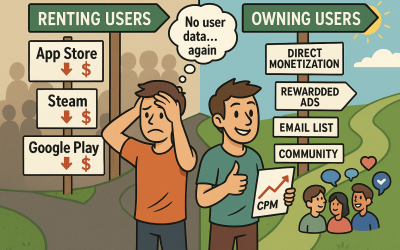Forget Silver Bullets – The Future of Gaming
In 2024, the gaming industry finds itself navigating a challenging landscape. Advertisers are scaling back, revenue growth is unpredictable, and many companies are facing shrinking headcounts. It’s a tough reality, and no magic solution exists to solve it all at once. However, while there’s no silver bullet, the gaming industry has an arsenal of promising strategies. The future of gaming lies in embracing change, fostering resilience, and deploying a multifaceted approach to overcome obstacles.
Here are key strategies reshaping gaming monetization and industry growth.
Contents
- 1 1. AI-Powered Creativity: Transforming Game Development and Monetization
- 2 2. Incentivized Channels and Deep Engagement: Monetization That Works
- 3 3. Mid-Sized Ad Networks: Innovating to Reclaim Market Share
- 4 4. Hybrid Monetization Models: A Balanced Approach to Revenue
- 5 5. The Future of Gaming: Adapting to Constant Change
- 6 Key Takeaways from Gamesforum: Building Resilience Through Strategy
- 7 Wrapping Up: Forget the Silver Bullet—Master Change
1. AI-Powered Creativity: Transforming Game Development and Monetization
Continuing on Forget Silver Bullets – The Future of Gaming post, Artificial Intelligence (AI) is revolutionizing creativity in gaming. From generating lifelike characters to creating unique environments, AI opens up new possibilities for game developers. But it’s not just enhancing gameplay; it’s also innovating how games are monetized.
AI-driven algorithms can help studios deliver more personalized ad experiences to players. By analyzing user behavior, AI can predict which ad content resonates most with individual players. This level of personalization is boosting player engagement with ads, which is crucial for in-game monetization. AI-based tools can also help developers produce high-quality creative assets more quickly and efficiently, cutting down on production costs while enhancing the player experience.
Moreover, AI enables dynamic ad placements tailored to the player’s in-game journey. For example, ads can be introduced in natural, non-disruptive ways that improve the player’s experience rather than detract from it. As a result, AI-powered creativity isn’t just improving the quality of games; it’s making them more profitable.
2. Incentivized Channels and Deep Engagement: Monetization That Works
Incentivized channels have become a primary way to generate revenue in games, particularly in mobile and web-based gaming. By rewarding players for engaging with ads or taking specific actions, these channels foster deep engagement. Players are increasingly receptive to rewarded video ads because they enhance their gaming experience by offering in-game currency, lives, or other benefits.
Unlike traditional ad placements, incentivized ads don’t interrupt gameplay. They empower players to choose when and how they engage with ads, improving both the experience and the ad’s effectiveness. Incentivized channels often lead to higher click-through rates and better conversion, as users are already engaged and interested in the reward.
As more developers and advertisers realize the benefits of incentivized engagement, these channels are rapidly growing. Platforms like AppLovin and Unity Ads offer extensive rewarded ad solutions, making it easy for developers to monetize without disrupting player experience. These incentivized channels are proving to be a sustainable, player-friendly solution in an otherwise uncertain advertising climate.
Continuing on Forget Silver Bullets – The Future of Gaming post, The ad tech industry is often dominated by giants like Google and Facebook, but mid-sized ad networks are emerging as powerful alternatives. These ad networks, which are more agile and customer-focused, are investing in technology and strategies to compete with larger players. Many are launching innovative ad formats and targeting techniques to drive more value for game developers.
For example, some mid-sized networks are adopting machine learning algorithms for more accurate audience targeting. By focusing on quality rather than quantity, these networks provide advertisers with better ad performance metrics. They also offer more transparent reporting and competitive pricing, which appeals to smaller studios and indie developers who may lack large budgets.
As these networks grow, they’re building strong relationships with developers who prefer flexibility and transparency. By prioritizing innovation and focusing on the needs of developers, mid-sized ad networks are reclaiming market share and redefining the ad landscape.
4. Hybrid Monetization Models: A Balanced Approach to Revenue
Hybrid monetization strategies are proving essential for sustainable growth in gaming. In the past, games relied heavily on either ads or in-app purchases (IAPs) for revenue. Today, developers are blending multiple revenue streams to create a more balanced monetization strategy that enhances player experience while maximizing revenue.
With a hybrid model, developers can combine rewarded video ads, in-game purchases, and subscription options. This diversity allows players to choose how they want to engage with monetization, avoiding the “paywall fatigue” that can drive users away. Hybrid models also mitigate revenue volatility; if one stream underperforms, the others help stabilize income.
For example, a game might offer a subscription option for ad-free gameplay while also including rewarded ads for users who prefer to play for free. This flexibility enhances player retention and expands the game’s monetization potential. Hybrid models cater to a variety of player preferences and ensure that developers don’t rely on a single revenue source, which is crucial in today’s uncertain economy.

5. The Future of Gaming: Adapting to Constant Change
Continuing on Forget Silver Bullets – The Future of Gaming post, The gaming industry has always been fast-paced, but the need to adapt has become even more crucial today. Markets are evolving, player preferences are shifting, and economic pressures are high. As developers and advertisers, the challenge is to stay nimble, innovating continuously to meet these changes head-on.
Constant change demands more than a quick fix. It requires a mindset that embraces experimentation, learning, and adaptability. Developers who keep refining their monetization models, exploring new technologies, and prioritizing player experience will be the ones to thrive.
Key Takeaways from Gamesforum: Building Resilience Through Strategy
Last but not least on Forget Silver Bullets – The Future of Gaming post, The Gamesforum insights make one thing clear: the gaming industry’s future won’t be defined by a single, miraculous solution. Instead, it will be shaped by strategies that evolve with the industry. Developers and advertisers need to adopt a multifaceted approach, focusing on resilience, flexibility, and innovation to navigate the challenges ahead.
- Invest in AI and automation to enhance creativity and streamline ad placements for personalized, engaging player experiences.
- Prioritize incentivized engagement channels to offer players value through rewarded ads, improving both engagement and revenue potential.
- Support and collaborate with mid-sized ad networks to diversify ad placements and benefit from cutting-edge technologies and audience targeting.
- Adopt a hybrid monetization model to offer diverse options for players and reduce dependence on any single revenue stream.
- Embrace a mindset of adaptability, continuously testing new monetization models, ad formats, and technologies to stay ahead.
Wrapping Up: Forget the Silver Bullet—Master Change
The future of gaming isn’t about finding a silver bullet. It’s about understanding that change is constant and learning to master it. Successful gaming companies are those that adopt a long-term view, innovate continuously, and maintain a player-first approach to monetization. By focusing on adaptable, hybrid strategies, the industry can look beyond short-term challenges to achieve sustained growth.
So as we look toward the future, let’s focus on grinding it out, adapting, and keeping players at the heart of every decision.



